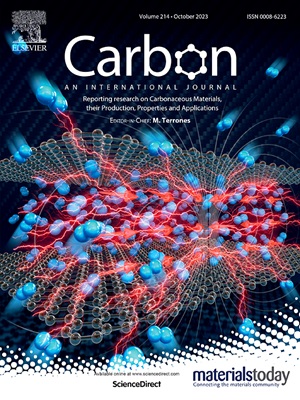Extreme current density and breakdown mechanism in graphene on diamond substrate
IF 10.5
2区 材料科学
Q1 CHEMISTRY, PHYSICAL
引用次数: 0
Abstract
The high current-carrying capacity of graphene is essential for its use as an interconnect in electronic and spintronic circuits. At the same time, knowing the breakdown limits and mechanism under high fields can enable new device design strategies. In this work, we push the current carrying capacity of the scalable form of chemical vapor deposited (CVD) graphene employing a high-thermal conducting single crystalline diamond substrate. Our experiments on CVD graphene reveal extremely high current densities > 109 A/cm2 in graphene on the diamond with both ohmic (low-resistive) and tunneling (high-resistive) contacts. Measurements on ferromagnetic (TiOx/Co) and metallic (Ti/Au) contacts demonstrate current densities of ∼1.16 × 109 A/cm2 and ∼1.7 × 109 A/cm2, respectively. The tunnel (high-resistive) contacts exhibit a shunting of graphene under high currents via the bottom graphitized diamond, resulting in dielectric breakdown and via alternative conducting paths. Electrical measurements show a distinct threshold for conducting paths of graphitized diamond, in tune accordance with Middleton-Wingreen's theory. Our results of high current densities achieved in CVD graphene, with distinct dependence on ohmic and tunneling, contact resistance, and the observed breakdown mechanism, provide new insights for enabling high-current all carbon circuits.

求助全文
约1分钟内获得全文
求助全文
来源期刊

Carbon
工程技术-材料科学:综合
CiteScore
20.80
自引率
7.30%
发文量
0
审稿时长
23 days
期刊介绍:
The journal Carbon is an international multidisciplinary forum for communicating scientific advances in the field of carbon materials. It reports new findings related to the formation, structure, properties, behaviors, and technological applications of carbons. Carbons are a broad class of ordered or disordered solid phases composed primarily of elemental carbon, including but not limited to carbon black, carbon fibers and filaments, carbon nanotubes, diamond and diamond-like carbon, fullerenes, glassy carbon, graphite, graphene, graphene-oxide, porous carbons, pyrolytic carbon, and other sp2 and non-sp2 hybridized carbon systems. Carbon is the companion title to the open access journal Carbon Trends. Relevant application areas for carbon materials include biology and medicine, catalysis, electronic, optoelectronic, spintronic, high-frequency, and photonic devices, energy storage and conversion systems, environmental applications and water treatment, smart materials and systems, and structural and thermal applications.
 求助内容:
求助内容: 应助结果提醒方式:
应助结果提醒方式:


